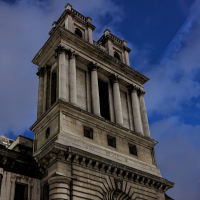Notre Dame
Comments
-
DeVlaeminck wrote:Rolf F wrote:DeVlaeminck wrote:I'd like them to modernise rather than just rebuild as was even if rebuilding as was is possible. Keep what can be saved of course.
Why? Concrete and glass? Uglify it? Look at Coventry cathedral. An ugly badly made eyesore. At least the original Cathedral was really just a big parish church but France does not need that sort of philistine solution.
As it happens, my first visit to Notre Dame was probably my worst experience of very many Cathedral/greater church visits. Shuffling through amid a virtual crush of people. Second time much better. Joined the queue before opening. Then the heavens opened and the queue dispersed. We were happy to wait five minutes more in the rain and enjoy the impressive interior when largely empty.
This is its problem - it is an immensely popular attraction. I suppose wrecking it by a thoughtless rebuild would be one solution to that problem.
OK just caught up with this. My answer would be why is anything new necessarily ugly, why must a rebuild be thoughtless?
Is it impossible to create something modern yet pleasing to the eye, or do you just doubt that they would achieve that even if their intentions and budget were good?
I actually quite like Coventry Cathedral though so I may not be the person to convince you!!
As mentioned above, I do like concrete in its place but most of the good concrete isn't exactly recent. But modern buildings are now tending to be built with an expectation of short lives and even if they aren't, they get rebuilt every five minutes. I suspect that there are a lot more surviving 1930s interiors than there are say, surviving 1970s interiors because of the modern obsession with ripping interiors out every five minutes. Nothing lasts long enough to be worth preserving.
I guess it depends on where you are and what you see - in Leeds I fear that the city will end up looking like Manchester which, if you've not been there, is the worst place in the North apart from Liverpool and Bradford. And some other places maybe..... Seriously though, it's a hideous craphole with a vast amount of recent terrible modern blocks of inappropriate scale creating a very unhuman place to be in. Leeds has already made one big mistake (Bridgewater place - a piece of architecture so bad that they've had to put huge wind breaks on the side of it to stop lorries getting blown onto pedestrians) and show no signs of having learned the lesson. I'd rather a few cities like Paris (there really aren't many of them) continue to value the past and avoid the circling sharks of architects keen to stick their latest predictable concrete and glass wet dream onto something that deserves much better (though on a good day Calatrava might come up with something elegant spire wise). How much nicer London would be if it had been treated the same way as Paris......Faster than a tent.......0 -
Rick Chasey wrote:Tell you what, owning a house makes you extra dull doesn't it? I'm boring myself.
Haha, yes! Be careful... I can now spot F&B colours at ten paces.Ben
Bikes: Donhou DSS4 Custom | Condor Italia RC | Gios Megalite | Dolan Preffisio | Giant Bowery '76
Instagram: https://www.instagram.com/ben_h_ppcc/
Flickr: https://www.flickr.com/photos/143173475@N05/0 -
Rolf F wrote:
(Bridgewater place - a piece of architecture so bad that they've had to put huge wind breaks on the side of it to stop lorries getting blown onto pedestrians) and show no signs of having learned the lesson. I'd rather a few cities like Paris (there really aren't many of them) continue to value the past and avoid the circling sharks of architects keen to stick their latest predictable concrete and glass wet dream onto something that deserves much better (though on a good day Calatrava might come up with something elegant spire wise). How much nicer London would be if it had been treated the same way as Paris......
In general I agree, I just thought given the likely cost (I'm guessing here) of rebuilding something like Notre Dame that given a similar budget something really good could be created but saving what can be saved.
As far as modern architecture goes I always think it's the smaller cities that get the real rough end of the stick - where there isn't the money to even pretend that modern buildings have merit.[Castle Donington Ladies FC - going up in '22]0 -
Rolf F wrote:Bridgewater place - a piece of architecture so bad that they've had to put huge wind breaks on the side of it to stop lorries getting blown onto pedestrians...
... after the horse has bolted. What was the outcome of that case - did the Architect et al get away with it in the end?Ben
Bikes: Donhou DSS4 Custom | Condor Italia RC | Gios Megalite | Dolan Preffisio | Giant Bowery '76
Instagram: https://www.instagram.com/ben_h_ppcc/
Flickr: https://www.flickr.com/photos/143173475@N05/0 -
Concrete cathedral. It is 50 years old though.


 0
0 -
rjsterry wrote:awavey wrote:Surrey Commuter wrote:Rick Chasey wrote:Why, are the budgets considerably higher?
By the end of my own refurb I had got surprisingly good at costing up building work. Certainly good enough to know that architects are talking sh1te when they claim to be surprised that their plans cost double your budget.
but where would be the drama without a Kevin McCloud side glance and roll of the eyes at the camera ? with the tension of will they afford it during the ad breaks...its TV still remember
Let's just say there is considerable dramatic licence employed in deciding what footage ends up in the final programme.
I would have thought an architect would just watch for the building not the drama. That bit is hard to fake.0 -
Ben6899 wrote:Rolf F wrote:Bridgewater place - a piece of architecture so bad that they've had to put huge wind breaks on the side of it to stop lorries getting blown onto pedestrians...
... after the horse has bolted. What was the outcome of that case - did the Architect et al get away with it in the end?
I think that the architects got away with it - presumably they aren't expected to know what the consequences of their designs are in terms of death rate. Despite the silly wind deflectors it still gets closed on windy days. Owners had to contribute to the deflectors at least. I daresay that there is a certain reduction in wind velocity but I can't tell the difference; it doesn't need exceptional winds to make it nasty.
It's a thoroughly unpleasant area to work and be in (aside from the wind, it is gloomy, grey and dark and the pavements aren't wide enough for the number of people using them) the only saving grace being the excellent Grove pub which looks very out of place there now.Faster than a tent.......0 -
Rolf F wrote:rjsterry wrote:I'd missed that as well. Rolf seems to be outing himself as BR's answer to the Prince of Wales.
Given that *the* thing about Gothic church architecture was the development of larger and larger windows, using more and more glass, I'd have thought glass would the perfect material to feature in whatever new roof is built.
Not entirely! For example, I rather liked St Josephs in Le Havre. But most cities and places are a mish mash of old and new and I see no reason to mess around with something that was perfect as it was.
Apart from the fact it burned down and needs rebuilding?
I also don't see a reason why more modern types of material have to be ugly, it's the architecture rather than the materials in most cases.0 -
HaydenM wrote:Rolf F wrote:rjsterry wrote:I'd missed that as well. Rolf seems to be outing himself as BR's answer to the Prince of Wales.
Given that *the* thing about Gothic church architecture was the development of larger and larger windows, using more and more glass, I'd have thought glass would the perfect material to feature in whatever new roof is built.
Not entirely! For example, I rather liked St Josephs in Le Havre. But most cities and places are a mish mash of old and new and I see no reason to mess around with something that was perfect as it was.
Apart from the fact it burned down and needs rebuilding?
I also don't see a reason why more modern types of material have to be ugly, it's the architecture rather than the materials in most cases.
Biblically speaking you can't put new wine in old wineskins. Matthew 9:14–17, Mark 2:21–22, and Luke 5:33–39 All well known architects.0 -
Rolf F wrote:I think that the architects got away with it - presumably they aren't expected to know what the consequences of their designs are in terms of death rate.
Not in as many words, no. But there are Codes which help designers understand existing prevailing wind strengths and directions, and how proposals will have an impact on them.
It'd be interesting to see the calcs.Ben
Bikes: Donhou DSS4 Custom | Condor Italia RC | Gios Megalite | Dolan Preffisio | Giant Bowery '76
Instagram: https://www.instagram.com/ben_h_ppcc/
Flickr: https://www.flickr.com/photos/143173475@N05/0 -
HaydenM wrote:Rolf F wrote:rjsterry wrote:I'd missed that as well. Rolf seems to be outing himself as BR's answer to the Prince of Wales.
Given that *the* thing about Gothic church architecture was the development of larger and larger windows, using more and more glass, I'd have thought glass would the perfect material to feature in whatever new roof is built.
Not entirely! For example, I rather liked St Josephs in Le Havre. But most cities and places are a mish mash of old and new and I see no reason to mess around with something that was perfect as it was.
Apart from the fact it burned down and needs rebuilding?
I also don't see a reason why more modern types of material have to be ugly, it's the architecture rather than the materials in most cases.
You have seen pictures of it post fire haven't you? Notre Dame didn't burn down; apart from the roof it is almost entirely intact. For the most part, it just needs the roof and crossing vault replacing. If somebody drives into your car do you get a matching replacement bumper fitted or stick on a racing nose with stripes on it?
You are partly right about the architecture being the most important but often the two go hand in hand. One problem with modern materials/methods is that they often age badly. Concrete stains badly, expansive glass often quickly looks grimy (eg the Louvre pyramid), alternatives look cheap (eg Birmingham Grand Central - a "glass" roof that looked discoloured from the day the place opened). "Natural" materials tend to mellow with age. Man made materials tend not to. And in the long term they are often more expensive to maintain; they are chosen not because they are the best materials but because they are cheapest to build with. The future problem is someone elses.Faster than a tent.......0 -
Rick Chasey wrote:rjsterry wrote:Surrey Commuter wrote:rjsterry wrote:Surrey Commuter wrote:Rick Chasey wrote:Why, are the budgets considerably higher?
By the end of my own refurb I had got surprisingly good at costing up building work. Certainly good enough to know that architects are talking sh1te when they claim to be surprised that their plans cost double your budget.
More often than not it's a case of champagne tastes; beer money, and a refusal to reconcile one with the other.
Maybe but a bloke at work gave an architect a budget of £150k to modernise a 200 square metre house in Surrey. Bloke came back with side extension, rear extension and a loft conversion. Interestingly he refused to pay the architect on the grounds that he had not answered the brief.
I can't speak for others in my profession, but I've missed out on a couple of projects recently, because I told the potential clients that their ideas and budget didn't match.
What would you advise to potential customers?
I always have an innate suspicion that it’s all in their interest to hike the prices up because of asymmetric information, so I would naturally err towards any architect who would say they could do it for the lowest price.
I imagine this is not the whole story but hard to know if that behaviour is rife or not.
The joys of professional consultancy in any line of work. I've lost out on jobs plenty of times not just on cost but on telling the client a realistic timescale for getting through all the red tape (and the time involved in getting through that red tape needs to be reflected in the cost). Tell someone who has watched too many property development TV programmes and bought a site with outline planning consent for half a dozen houses that they can't start building until they have their access approved by the Council and that it is likely to take at least 6 months they'll go to someone who will fail to advise them of that but 6 months down the line you take a look at the site and it hasn't started. Part of providing design consultancy in any field is (or should be) giving the Client a reality check based on your experience and knowledge not telling them what they want to hear in the hope they'll appoint you. I've taken the philosophy that the sort of Clients that argue over fees and programme aren't the ones I want to work with as they usually end up being bad at paying their bills as well.0 -
Rolf F wrote:rjsterry wrote:I'd missed that as well. Rolf seems to be outing himself as BR's answer to the Prince of Wales.
Given that *the* thing about Gothic church architecture was the development of larger and larger windows, using more and more glass, I'd have thought glass would the perfect material to feature in whatever new roof is built.
Not entirely! For example, I rather liked St Josephs in Le Havre. But most cities and places are a mish mash of old and new and I see no reason to mess around with something that was perfect as it was.
As far as your suggestion of glass in the roof goes - how would that work. It would only be visible from the outside - not much light would get into the church unless you propose demolishing 13th century stone vaults at which point you might as well flatten the whole thing.
There's a big hole in the vault at the crossing. One of the great things about those English cathedrals with a central tower or lantern is that shaft of light in the centre of the church. Glass also lets light out, which would make quite a landmark at night.Rolf F wrote:As mentioned above, I do like concrete in its place but most of the good concrete isn't exactly recent. But modern buildings are now tending to be built with an expectation of short lives and even if they aren't, they get rebuilt every five minutes. I suspect that there are a lot more surviving 1930s interiors than there are say, surviving 1970s interiors because of the modern obsession with ripping interiors out every five minutes. Nothing lasts long enough to be worth preserving.
This doesn't really have a basis in reality. Interiors are replaced because they wear out or do not serve the needs of the occupants. If a viable use ceases to exist - whether that's an empty church with no congregation or an office building with no tenants - why should anyone pay for its upkeep unless an alternative use can be found? You might say that some buildings are of such exceptional quality or cultural significance that they should be maintained for their own sake, but they will still need a viable way to provide an income to pay for that maintenance.
Different building types have different requirements for their intended lifespan and materials are specified accordingly. An office building is likely to be a speculative development and will have a series of changing tenants with their own varied needs so a short lifespan is appropriate for the interiors with just the core structure and services designed to a longer lifespan. More durable materials with a longer lifespan tend to have a higher financial and environmental cost, so an office interior built to last 60 years would be a waste of resources. A cathedral on the other hand will have a relatively fixed set of functional requirements and much smaller income, so designing for a long lifespan is makes more sense.
There is an idea that all old buildings were built to last, but this is not the case. Many of what are now considered to be fine Georgian and Victorian terraces that are now Grade II listed were cheaply built as speculative developments. They are only still standing (in some cases barely) because people have had a use for them and so it is worth replacing and rebuilding the interiors and parts of the exterior.1985 Mercian King of Mercia - work in progress (Hah! Who am I kidding?)
Pinnacle Monzonite
Part of the anti-growth coalition0 -
Ben6899 wrote:Rolf F wrote:I think that the architects got away with it - presumably they aren't expected to know what the consequences of their designs are in terms of death rate.
Not in as many words, no. But there are Codes which help designers understand existing prevailing wind strengths and directions, and how proposals will have an impact on them.
It'd be interesting to see the calcs.
I very much doubt they got away with it. More likely there was a settlement that was not reported. Their PI premiums will have gone up significantly as a result.1985 Mercian King of Mercia - work in progress (Hah! Who am I kidding?)
Pinnacle Monzonite
Part of the anti-growth coalition0 -
Rolf F wrote:HaydenM wrote:Rolf F wrote:rjsterry wrote:I'd missed that as well. Rolf seems to be outing himself as BR's answer to the Prince of Wales.
Given that *the* thing about Gothic church architecture was the development of larger and larger windows, using more and more glass, I'd have thought glass would the perfect material to feature in whatever new roof is built.
Not entirely! For example, I rather liked St Josephs in Le Havre. But most cities and places are a mish mash of old and new and I see no reason to mess around with something that was perfect as it was.
Apart from the fact it burned down and needs rebuilding?
I also don't see a reason why more modern types of material have to be ugly, it's the architecture rather than the materials in most cases.
You have seen pictures of it post fire haven't you? Notre Dame didn't burn down; apart from the roof it is almost entirely intact. For the most part, it just needs the roof and crossing vault replacing. If somebody drives into your car do you get a matching replacement bumper fitted or stick on a racing nose with stripes on it?
You are partly right about the architecture being the most important but often the two go hand in hand. One problem with modern materials/methods is that they often age badly. Concrete stains badly, expansive glass often quickly looks grimy (eg the Louvre pyramid), alternatives look cheap (eg Birmingham Grand Central - a "glass" roof that looked discoloured from the day the place opened). "Natural" materials tend to mellow with age. Man made materials tend not to. And in the long term they are often more expensive to maintain; they are chosen not because they are the best materials but because they are cheapest to build with. The future problem is someone elses.
Was interested to view the One Show feature on the York Minster restoration post fire. That's the standard the Notre Dame restorers have to reach IMO. I am pretty sure they will.
It's not by chance that Paris has just one skyscraper. The city planners decided to retain the city's human scale by resisting commercial pressures and restricting the height of buildings.
In London the planners had to fight tooth and nail to ensure that the view of St Paul's was not totally destroyed by vast constructions.
Whilst the Canary Wharf Tower (for example*) is highly recognisable, it is hardly a building to raise the human spirit; some buildings are meant to do the opposite.
I met a traveller from an antique land,
Who said—“Two vast and trunkless legs of stone
Stand in the desert. . . . Near them, on the sand,
Half sunk a shattered visage lies, whose frown,
And wrinkled lip, and sneer of cold command,
Tell that its sculptor well those passions read
Which yet survive, stamped on these lifeless things,
The hand that mocked them, and the heart that fed;
And on the pedestal, these words appear:
My name is Ozymandias, King of Kings;
Look on my Works, ye Mighty, and despair!
Nothing beside remains. Round the decay
Of that colossal Wreck, boundless and bare
The lone and level sands stretch far away.”
*Other towers are available.0 -
Rolf F wrote:HaydenM wrote:Rolf F wrote:rjsterry wrote:I'd missed that as well. Rolf seems to be outing himself as BR's answer to the Prince of Wales.
Given that *the* thing about Gothic church architecture was the development of larger and larger windows, using more and more glass, I'd have thought glass would the perfect material to feature in whatever new roof is built.
Not entirely! For example, I rather liked St Josephs in Le Havre. But most cities and places are a mish mash of old and new and I see no reason to mess around with something that was perfect as it was.
Apart from the fact it burned down and needs rebuilding?
I also don't see a reason why more modern types of material have to be ugly, it's the architecture rather than the materials in most cases.
You have seen pictures of it post fire haven't you? Notre Dame didn't burn down; apart from the roof it is almost entirely intact. For the most part, it just needs the roof and crossing vault replacing. If somebody drives into your car do you get a matching replacement bumper fitted or stick on a racing nose with stripes on it?
You are partly right about the architecture being the most important but often the two go hand in hand. One problem with modern materials/methods is that they often age badly. Concrete stains badly, expansive glass often quickly looks grimy (eg the Louvre pyramid), alternatives look cheap (eg Birmingham Grand Central - a "glass" roof that looked discoloured from the day the place opened). "Natural" materials tend to mellow with age. Man made materials tend not to. And in the long term they are often more expensive to maintain; they are chosen not because they are the best materials but because they are cheapest to build with. The future problem is someone elses.
Concrete collects dirt in much the same way as stone or brick. It's mostly down to the detailing to manage how rainwater runs off a building, and to the degree of dirt in the air. Georgian Bath with its famous yellow stone was mostly black when everyone heated their homes with coal.
Not sure what you mean by natural materials: they're all manufactured and processed to some degree.1985 Mercian King of Mercia - work in progress (Hah! Who am I kidding?)
Pinnacle Monzonite
Part of the anti-growth coalition0





